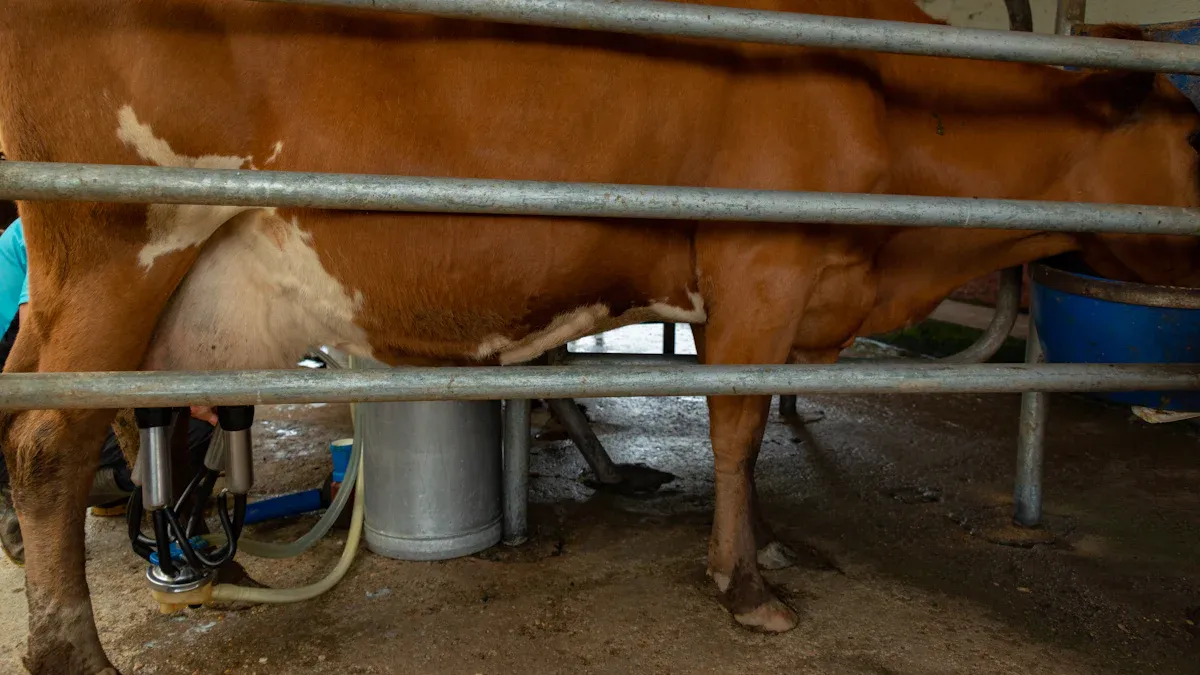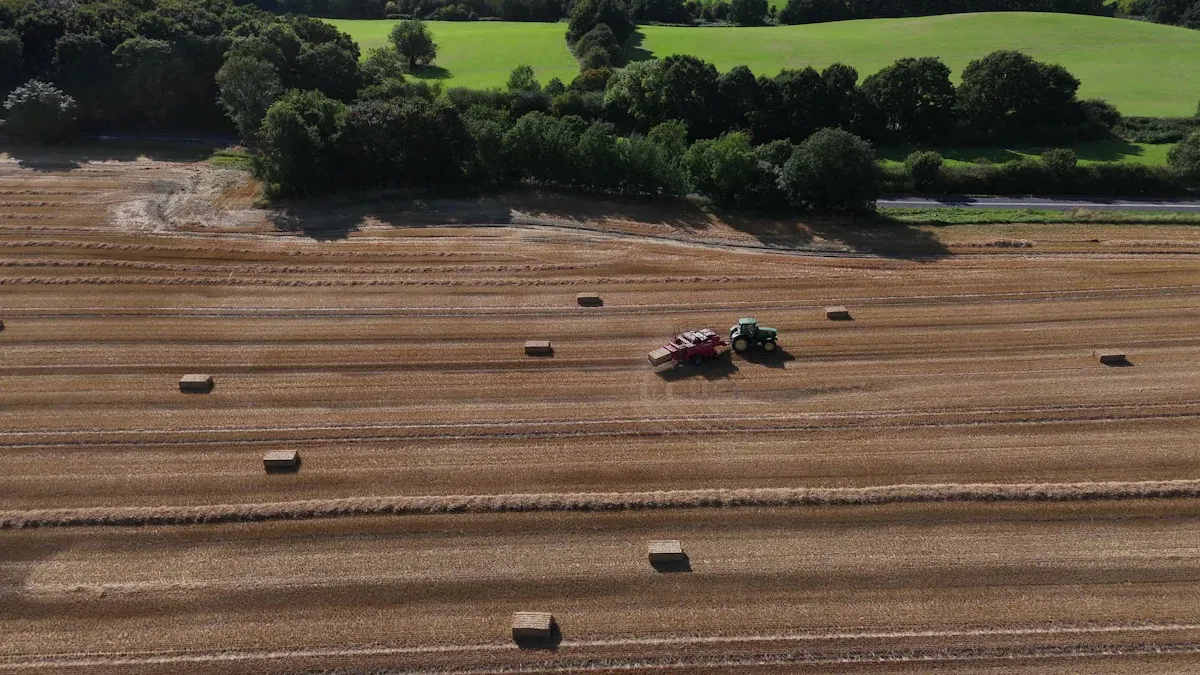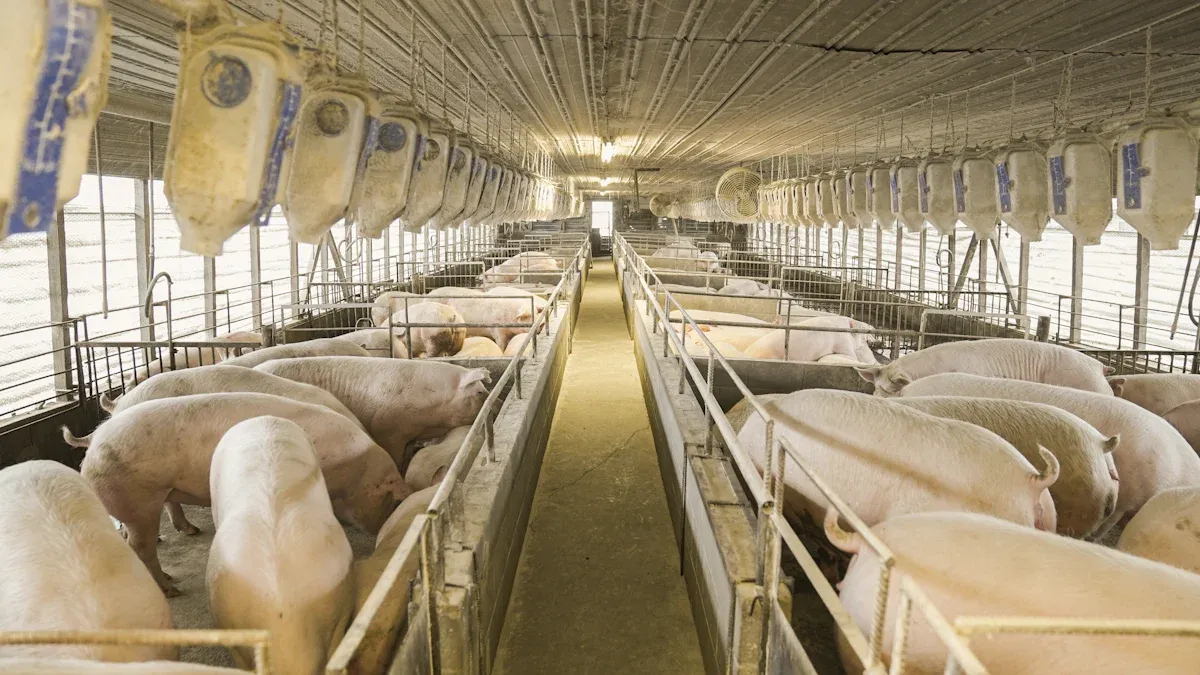
Versatile AI Equipment transforms livestock breeding by allowing seamless artificial insemination across cattle, pigs, and other animals. Farmers use a single set of tools to manage multiple species, which reduces equipment costs and increases productivity. This adaptability supports both specialized and mixed-species operations. Transitions between different animals become faster and more efficient, helping farms maintain high standards in reproductive management.
Key Takeaways
- Versatile AI equipment works for many livestock species, letting farmers use one set of tools for cattle, pigs, sheep, goats, and horses.
- Adjustable parts and universal connectors make the equipment easy to switch between animals, saving time and reducing costs.
- Using adaptable AI tools improves breeding success by increasing conception rates and reducing stress on animals and operators.
- Farms benefit from simpler training, better inventory management, and faster breeding cycles with versatile equipment.
- Choosing high-quality, easy-to-use AI equipment supports animal health, farm efficiency, and long-term productivity.
What Makes Versatile AI Equipment Adaptable?
Key Features for Multi-Species Use
Versatile AI Equipment stands out because it adapts to the unique needs of different livestock species. Manufacturers design these tools with flexibility in mind, allowing farmers to use the same equipment for cattle, pigs, sheep, goats, and even horses. This adaptability comes from several important features:
- Adjustable Components: Many AI tools include interchangeable parts, such as different-sized sheaths or catheters, to fit the anatomy of various animals.
- Universal Connectors: Equipment often uses connectors that work with multiple types of semen containers and extenders, making it easy to switch between species.
- Durable Materials: High-quality plastics and stainless steel ensure that the equipment withstands repeated use and cleaning, which is essential for biosecurity across species.
- User-Friendly Design: Clear markings, ergonomic handles, and intuitive assembly help farm staff perform procedures accurately, regardless of the animal.
- Compatibility with Semen Preservation Methods: The best equipment supports fresh, chilled, and frozen semen, which is crucial for different reproductive cycles and species requirements.
Note: Farms that use adaptable AI equipment can streamline their breeding programs and reduce the need for species-specific training. This approach saves time and helps maintain consistent results across the herd or flock.
Examples of Versatile AI Technologies
Several technologies have shaped the development of adaptable AI equipment for livestock. These innovations allow farms to achieve high breeding efficiency and genetic improvement across multiple species. Some leading examples include:
- Semen preservation methods, such as fresh, chilled, and frozen semen, support use in cattle, pigs, sheep, goats, and horses.
- Semen extenders and artificial vaginas play a key role in collecting and preserving semen for different species.
- Insemination techniques vary by animal and include vaginal, cervical, intrauterine, and transcervical methods, showing the need for adaptable tools.
- Frozen semen technology, developed in the mid-20th century, allows worldwide transport and use in diverse livestock populations.
- AI programs use semen from genetically superior males, improving breeding efficiency and animal quality across species.
- Wildlife management also benefits from AI, especially with fresh or chilled semen, though protocols continue to evolve for more exotic species.
| Technology | Species Supported | Key Benefit |
|---|---|---|
| Semen Extenders | Cattle, Swine, Sheep, Goats, Horses | Maintains semen viability |
| Artificial Vaginas | Cattle, Horses, Sheep | Enables safe and effective collection |
| Frozen Semen Technology | Cattle, Swine, Sheep, Goats | Allows global distribution |
| Universal Insemination Guns | Cattle, Swine, Sheep | Simplifies multi-species use |
These technologies demonstrate how versatile AI equipment enables farms to manage breeding programs efficiently, regardless of the species involved.
Versatile AI Equipment Applications Across Livestock

Cattle (Bovine) Use Cases
Cattle breeding operations rely on advanced tools to achieve consistent reproductive success. Versatile AI Equipment supports farmers by offering adaptable features that fit the anatomy of cows and heifers. Operators use these tools to improve fertility rates and optimize breeding outcomes. The equipment reduces stress for both animals and handlers, thanks to ergonomic designs and easy maneuverability. Adjustable nozzles allow seamless transitions between different breeds and even other livestock species.
- Enhances fertility rates through precision technology
- Optimizes breeding outcomes by ensuring successful insemination
- Reduces stress on both animals and operators during the breeding process
- Designed for ergonomic handling and easy maneuverability
- Versatile across different livestock species due to adjustable nozzle
- Supports sustainable agricultural goals by promoting healthier livestock production
- Improves productivity and profitability in cattle breeding operations
Tip: Farms that invest in adaptable insemination tools often see higher conception rates and healthier calves. These improvements contribute to long-term sustainability and profitability.
Swine (Pig) Use Cases
Pig breeding presents unique challenges that require specialized equipment. Versatile AI Equipment addresses these needs with features such as flexible catheters and universal connectors. Farmers use these tools to perform intrauterine and cervical insemination efficiently. The equipment supports both large-scale commercial operations and smaller family farms. Operators benefit from reduced training time, as the same tools work across different breeds and sizes of pigs.
A typical swine breeding process involves:
- Preparing the sow or gilt for insemination.
- Using a flexible catheter to deliver semen directly to the uterus.
- Ensuring proper hygiene and biosecurity throughout the procedure.
- Monitoring the animal for signs of successful conception.
A table below highlights the advantages of using adaptable equipment in swine operations:
| Feature | Benefit |
|---|---|
| Flexible Catheter | Reduces risk of injury |
| Universal Connector | Simplifies semen delivery |
| Ergonomic Handle | Improves operator comfort |
| Multi-Species Design | Enables use across livestock |
Other Livestock Species
Versatile AI Equipment extends its benefits beyond cattle and pigs. Sheep, goats, and horses also require precise and gentle handling during artificial insemination. Farmers use interchangeable sheaths and adjustable components to accommodate different anatomical structures. These tools support vaginal, cervical, and transcervical insemination methods, ensuring high conception rates across species.
Operators working with mixed-species farms appreciate the simplicity of using one set of equipment for multiple animals. This approach streamlines inventory management and reduces costs. Wildlife managers also adopt these technologies to support conservation breeding programs, especially for rare or endangered species.
Note: Adaptable insemination equipment helps farms maintain high standards of animal welfare and reproductive efficiency, regardless of the species involved.
Benefits of Versatile AI Equipment
Cost Savings and Operational Efficiency
Versatile AI Equipment helps farms reduce expenses by allowing the same set of tools to serve multiple species. Farmers no longer need to purchase separate equipment for cattle, pigs, sheep, or goats. This approach lowers initial investment and ongoing maintenance costs. Inventory management becomes simpler because fewer unique items require storage and tracking. Many farms report faster breeding cycles and less downtime between procedures. Operators can switch between species quickly, which increases the number of animals inseminated in a single day.
Farms that use adaptable equipment often see a boost in productivity and a decrease in wasted resources.
Simplified Management and Training
Managing livestock breeding becomes easier when staff use one system for different animals. Training new employees takes less time because they learn a single set of procedures. This consistency reduces mistakes and improves overall breeding success. Farm managers can standardize protocols, making it easier to monitor performance and maintain quality control. Staff confidence grows as they become familiar with the equipment, leading to smoother operations.
- New hires adapt quickly to standardized tools.
- Fewer errors occur during insemination procedures.
- Managers track results more efficiently.
Enhanced Animal Health and Productivity
Versatile AI Equipment supports animal welfare and reproductive success. Artificial vaginas mimic natural conditions, which helps reduce animal stress during semen collection. Proper semen collection tubes keep samples clean, preserving sperm quality. Semen extenders protect sperm viability and prevent bacterial growth, which supports successful insemination. Ultrasound machines and ovulation detectors help time insemination precisely, increasing pregnancy rates. Sterilization and hygiene practices lower infection risks, which benefits animal health. Water-based, non-spermicidal lubricants minimize irritation, supporting both sperm viability and animal comfort.
- Lower stress levels during breeding procedures
- Higher conception and pregnancy rates
- Improved animal comfort and welfare
Consistent use of high-quality, adaptable equipment leads to healthier livestock and better reproductive outcomes.
Choosing the Right Versatile AI Equipment
Compatibility and Adaptability
Selecting the right artificial insemination tools requires careful attention to compatibility and adaptability. Farmers should look for equipment that matches the needs of different species and operational scales. Material composition plays a key role. Stainless steel offers durability and resists corrosion, while medical-grade plastic and silicone provide flexibility and comfort for animals. Temperature control ensures semen viability, with advanced systems maintaining precise regulation. Capacity options must align with the semen volume requirements of each species. Precision in semen delivery supports animal safety and successful insemination. Design features such as ergonomic handles, rotatable parts, and visual aids like cameras improve usability and species compatibility. Cleanability remains essential for hygiene, especially in high-frequency use.
| Criterion | Description | Importance for Compatibility and Adaptability |
|---|---|---|
| Material Composition | Stainless steel, medical-grade plastic, silicone | Ensures durability, hygiene, animal comfort, and suitability for sterilization |
| Temperature Control | Advanced (±0.5°C), Moderate (±1°C), Basic (±2°C) | Maintains semen viability |
| Capacity | Low (0.1-0.3 mL), Medium (0.5-1.0 mL), High (1.5-3.0 mL) | Matches semen volume requirements |
| Precision | Accurate semen delivery | Critical for successful insemination |
| Design | Tailored anatomy, ergonomic handles, rotatable parts, cameras | Enhances ease of use and compatibility |
| Cleanability | High, medium, low cleanability | Important for hygiene |
| Compatibility Features | Adjustable temperature, various straw sizes | Supports multi-species use |
| Adaptability Features | Rotatable screens, built-in cameras, suitability for various livestock | Enables effective use in diverse contexts |
Ease of Use and Integration
Ease of use stands as a top priority for livestock operations. Equipment with intuitive assembly and clear markings allows staff to perform procedures accurately. Ergonomic handles reduce fatigue during repetitive tasks. Visual aids, such as built-in cameras or rotatable screens, help operators monitor placement and technique. Integration with existing farm protocols ensures smooth adoption. Farms benefit from tools that accommodate different straw sizes and semen types, making transitions between species efficient. Simple cleaning procedures and modular parts further support daily workflow.
Tip: Choose equipment that minimizes training time and supports consistent results across all livestock species.
Support, Quality, and Updates
Reliable support and consistent quality define successful artificial insemination programs. Manufacturers who prioritize quality control, such as strict supplier selection and thorough product testing, deliver dependable equipment. Farms should seek suppliers who offer responsive customer service and provide regular updates or improvements to their products. Photo documentation of production stages and client confirmation before delivery demonstrate a commitment to transparency. High-quality Versatile AI Equipment ensures long-term durability, animal safety, and operational efficiency.
Real-World Success with Versatile AI Equipment

Case Study: Transition from Bovine to Swine
A livestock operation in Denmark faced the challenge of expanding from cattle breeding to swine production. The farm manager evaluated equipment options and selected a system with adjustable components and universal connectors. The team trained staff to use the same insemination tools for both cows and sows. The transition process included:
- Reviewing anatomical differences between cattle and pigs.
- Swapping out sheaths and catheters for species-specific procedures.
- Implementing hygiene protocols for cross-species use.
The farm reported a 30% reduction in equipment costs after switching to adaptable tools. Staff completed insemination procedures faster and with fewer errors. The manager noted improved conception rates in both cattle and pigs. The operation maintained high standards for animal welfare and biosecurity.
Note: Farms that invest in adaptable technology can respond quickly to market changes and diversify their livestock operations.
Case Study: Multi-Species Farm Implementation
A mixed-species farm in Australia managed cattle, sheep, and goats. The owner sought a solution to streamline breeding across all animals. The team adopted equipment with interchangeable parts and ergonomic handles. Staff used the same insemination guns and extenders for each species. The farm benefited in several ways:
| Benefit | Impact on Farm Operations |
|---|---|
| Reduced Inventory | Lowered storage requirements |
| Simplified Training | Faster onboarding for new staff |
| Consistent Results | Higher conception rates |
| Improved Efficiency | Increased daily breeding numbers |
The owner observed that standardized equipment improved workflow and reduced downtime. Staff felt confident using the tools for different animals. The farm achieved better reproductive outcomes and increased overall productivity.
Tip: Multi-species farms can maximize resources and simplify management by choosing adaptable insemination equipment.
Livestock operations achieve greater efficiency and adaptability by using advanced artificial insemination tools for multiple species. Research shows that artificial insemination improves breeding outcomes in horses and other animals, often surpassing natural mating. Farms benefit from genetic improvement, disease control, and streamlined management. As global demand for protein rises, investment in these technologies supports herd performance and aligns with market trends. This approach helps producers meet animal welfare standards and respond quickly to changing consumer needs.
FAQ
What livestock species can versatile AI equipment support?
Versatile AI equipment works with cattle, pigs, sheep, goats, and horses. Many systems include adjustable parts and universal connectors. This flexibility allows farms to use one set of tools for multiple species.
How does versatile AI equipment improve farm efficiency?
Operators save time by switching between species without changing equipment. Staff training becomes easier. Inventory management simplifies. Farms report faster breeding cycles and higher productivity.
Is special training required to use adaptable AI equipment?
Most manufacturers design equipment for easy use. Staff learn procedures quickly. Farms often provide short training sessions. Clear markings and ergonomic designs help reduce errors.
How do farms ensure equipment quality and safety?
Farms choose suppliers who test products thoroughly and inspect every stage of production. Many companies provide photo documentation and require client confirmation before delivery. This process ensures high standards for quality and safety.
Post time: Aug-13-2025
